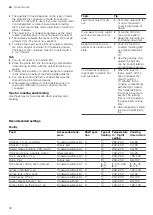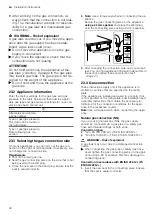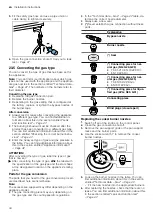
Installation instructions
en
47
5.
At this stage, it is important to test for leaks. You
can find additional information about this in the sec-
tion entitled "Leak and function test" →
Fitting the control panel
To reassemble, proceed in the reverse order of disas-
sembly.
1.
Take hold of the front panel with both hands and
carefully fit it into place. Ensure that the cables are
not damaged and the connections do not come
loose. Lower it slightly and insert it into the front
panel.
2.
Insert the screws (T15) (M4) that were removed
from the control panel.
3.
Insert and tighten the screws (T20) that were re-
moved from the front profiles on the right and left.
Attach the plastic covers.
4.
Carefully install the hob. Ensure that the plastic
parts which must remain underneath the screws do
not fall out. Unscrew the two screws (T20) on the
front left and right on the hob. If there are any
burner connection screws, screw them all into the
cooktop.
5.
Install the burner bases in their respective positions
according to their size. Make sure that the ignition
plugs are placed in the appropriate openings next
to the burner bases. Place the enamelled burner
lids onto the centre of the appropriate lower parts of
the burner and, in doing so, note the sizes.
‒
Fit the pan support grids and the pan support
racks. Ensure that the 80 mm pan support is fit-
ted on the auxiliary burner.
6.
If the appliance has a covering plate, hold it vertic-
ally by both sides and slowly reinsert it into the
holder.
7.
Carefully insert the knobs.
‒
At this stage, it is important to check that the gas
burners are burning correctly. You can find addi-
tional information about this in the section en-
titled "Checking the correct burner behaviour"
→
8.
Check whether the appliance is working correctly.
23.6 Leak test and function test
The leak test must be carried out by two people.
WARNING ‒ Risk of explosion!
Sparks, flames or open flames may cause explosions
during the leak and function test.
▶
Ensure that no sparks are produced.
▶
Do not use any fire or naked flames.
▶
Only check the leak tightness using a suitable foam.
Gas leak
¡
Close the gas connection locking device.
¡
Ventilate the relevant location sufficiently.
¡
Check the gas and nozzle connections once more.
¡
.
Checking the gas connection
1.
Open the gas connection shut-off.
2.
Apply suitable foam around the gas connection.
a
If dispersions and bubbles occur on the foamy sur-
face and these indicate that gas is escaping, follow
the instructions in the section entitled "What to do if
there is a gas leak" →
3.
Follow the same instructions for the part that is
sealed with the blind plug.
Checking the cooker burner nozzles
Check the leak tightness of each nozzle.
1.
Open the gas connection shut-off.
2.
To check, carefully cover the hole in the burner
nozzle with your finger or a special device.
3.
Apply suitable foam around the nozzle.
4.
Press on the burner knob and turn the knob anti-
clockwise. Gas therefore comes to the nozzle.
a
If dispersions and bubbles occur on the foamy sur-
face and these indicate that gas is escaping, follow
the instructions in the section entitled "What to do if
there is a gas leak" →
Checking the bypass nozzles
Check the leak tightness of each bypass nozzle.
1.
Open the gas connection shut-off.
2.
To check, carefully cover the hole in the burner
nozzle with your finger or a special device.
3.
Apply suitable foam around the bypass nozzle on
the burner that is to be checked.
4.
Press on the tap spindle and turn it anti-clockwise.
Gas therefore comes to the nozzle.
a
If dispersions and bubbles occur on the foamy sur-
face and these indicate that gas is escaping, follow
the instructions in the section entitled "What to do if
there is a gas leak" →
.
23.7 Checking the correct burner
behaviour
Check the burning and soot formation of each burner
after the product has been converted to a different gas
type. If there is a problem, compare the nozzle values
with the values in the table.
Checking the correct burner behaviour of the
cover burner
1.
Ignite the gas cooker burners in accordance with
the instructions in the operating manual.
→
"Operating the hotplate", Page 16
2.
Set the gas cooker knob to the small flame setting.
Check whether the flame safety system is working
by keeping the flame at the "small flame" setting for
one minute.
3.
Check that the burners are burning correctly with
both large and small flames.
a
The flame must burn evenly and steadily.
4.
Turn the burner knob back and forth quickly
between the large flame setting and the small flame
setting. Repeat this process several times.
a
The gas flame must not flicker or go out.
23.8 Technical data – Gas
The different types of gas and the corresponding val-
ues are listed.
Information on some types of gas
Note the following information for the gas types that are
listed in the table for some burners.





































